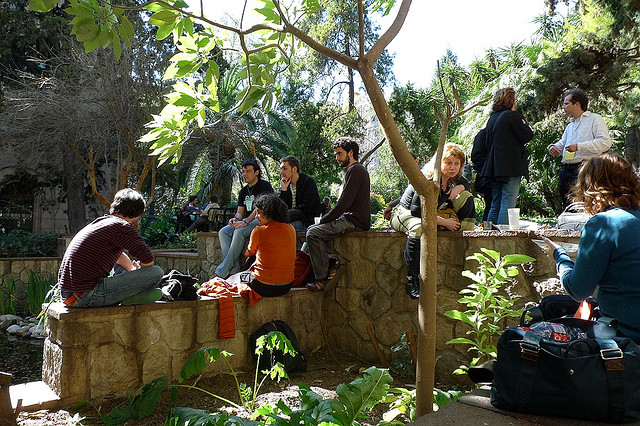Placing the notion of technology within a postgrowth setting is like introducing Conchita Wurst to a Vatican congregation. Not any congregation, but the Papal conclave. Not as a surprise guest to cheer everyone up, but as a serious proposal for the next Holy Father – or in this case: the Holy Trinity of the one, the other, and their unity. Technology? Are you sure? Technology is usually regarded as the dominant means to follow the futile dream of decoupling economic activity from ecological impact thus producing »green« growth – and thus cementing the capitalist, growth-oriented machine, responsible for environmental degradation, productivity increase and workers exploitation, acting as the materialist »perpetuum mobile« spewing out one gadget after the other in order to keep us fixed in our roles as mindless consumers, feeling ever more hollow down to our human core.
Despite this notion, technology has of course its place when talking about postgrowth or degrowth. You need different technologies with less ecological footprint, more attained to natural cycles, longer product life time, recycling and re-use, utilizing renewable sources of energy and so on. It is, however, very difficult to paint a clear picture of technology in the postgrowth economy when you are somehow stuck between a wind turbine and a composting toilet. So maybe it is a good idea to start at the beginning.
My point of departure here is social systems theory as developed by Niklas Luhmann. When we perceive technology as being a system, we abstract from the physical realizations of the wind turbine ore the composting toilet. Technology as system in Luhmannian terms implies to understand it as a self-making, autonomous, self-referential and closed enterprise. What technology is, what it does and what it becomes is only decided within technology and through technology. Technology in this very extreme view is neither natural or material, nor social or communication. It is technological; a distinct system in its own right. How can that be? Well, it is not very hard to understand that there are non-living, immaterial systems – just think of society or an organization. They do not live nor can you touch or lift them. Of course there are material manifestations to them: for example office buildings or work contracts written on paper materially signify the existence of an organization. However, these material manifestations »are« not the organization although they play an important role in its constitution and sustainability. A non-living, immaterial system can only be wholly perceived from a conceptual perspective. The same accounts for technology as system. So can we understand this conceptual perspective as a social one? Not really:
Technology and society are distinct autopoietic systems, structurally coupled together and able to irritate each other. Society can process technological irritations via communication, the basal operation of all social systems. And how about technology? Of course, a theory of technology as system is part of society. We can only socially construct our understanding of technology, just like astrophysics socially constructs our understanding of stars and galaxies. But stars and galaxies are not »inside« society; they remain firmly in the natural world. The same is with technology. It is not »inside« society; it remains technological through and through.
Once we accept that we cannot fully understand technology unless we find a valid conceptual perspective, and further accept system theory providing that perspective, technology becomes »alive«. Its basal operation can be visualized as information in a Batesonian sense: Information shall be understood here as a pattern that influences the formation and transformation of other patterns. A pattern shall be understood as an order of any sort. This applies to ideas, algorithms, and material manifestations regardless. Imagine a vinyl disc and the pick-up. The movement of the pick-up over the disc – or the movement of the disc under the pick-up – changes the state of information into a diachronic form, a before and after is observable. The transformation process of the engraved physical pattern into mechanical and electrical patterns is in itself information. It turns the uncertainty of what might be on the disc into the certainty of listening to Conchita Wurst.
The medium in which information takes form is operativeness: technology either works or it fails. All information in technology circles around information on operativeness of technology, just as all communication in social systems circles around communication of meaning in and about those systems. This is giving rise to the technological code, the techno-logic: work/fail. The evolution of technology as a system is then driven by information about the working or failing of technology, with working as the preferred side and with failing as useful information pointing to the directions to be avoided in future. Technology will then move into a direction which produces more information about what works, i.e. more patterns that have the ability to form and transform other patterns. If there are transformational patterns working on themselves and actually work in transforming themselves and giving rise to new and stable transformational patterns, we speak of technological evolution.
Now comes the interesting part: how technology impacts society and changes our lives. The easiest way is via the human individual, using its couplings to society i.e. language. The vast amount of media coverage and small talk about the iPhone speaks evidence about this way of coupling. The task for technology would then be to attract the attention of the human individual, to be practical in terms of physical application and attractive for cognitive processes, and thus forcing the human individual to turn technology into a communicative theme for society. The returning feedback from society would be sales in the economy enabling Apple to pay engineers and designers to create more and newer iPhones. Through multifold couplings between individual human beings, organizations and societal systems like the economy and politics, technology coevolves with them – and they coevolve with technology. And if you look at politics in post-democratic times and how ideology is neglected in favor of an almost Popperian or Baconian experimental mindset, I would argue that technology managed to infuse its work/fail code into society as a secondary, if not primary decision rule.
In other words: technology constructs society. Not the other way round. There is of course a large degree of recursiveness involved, but technology is dominant via its intense couplings to various function systems, infusing its work/fail code as a secondary decision logic, and via a direct coupling to the human body and mind through hard- and software interfaces. The cyborgs, or the servants of technology, are already there. My paper on »Technology as a system« is dealing intensely with this idea and gives a case for it by reconstructing the development of the automobile as the dominant technology for modern society. It should be read as a cautious warning against all forms of technological optimism as well as over-socialized perspectives on technology. But here I want to come back to postgrowth and some ideas from Ivan Illich on technology.
There are at least two notions from Illich that are of great significance to the postgrowth/degrowth discourse: counterproductivity and conviviality. Counterproductivity in short means that beyond a certain threshold of increase in technological productivity,, overall productivity in society will start to decrease again. The advent of the Boeing 707 in 1958 marked a peak in air travel velocity with a cruising speed of 550mph. The short-lived episode of supersonic commercial air travel aside, average cruising speed today is around 50mph slower than 50 years ago. Why? Because airlines have to save fuel due to higher costs – resulting from higher fuel consumption in the past which wascaused by an increase in air travel velocity. You can find many other examples, just think about the average traveling speed of a car in a big city today. Or the impact of Facebook on your own productivity… Every technology that distances people from themselves and nature while relying on large-scale infrastructures is bound to become counterproductive.
Conviviality on the other hand is in opposition to industrial productivity. It is a form of technology that is autonomous from large-scale infrastructures and is, directly or indirectly, reconnecting people with each other and their natural and social environments. In Illich’s own words, conviviality is considered »to be individual freedom realized in personal interdependence and, as such, an intrinsic ethical value.« While business-as-usual-technology becomes counterproductive and diminishes its own value and the value of peoples’ lives, convivial technology fights back counterproductivity and enhances community and well-being.
Conviviality is not »just« technology. It is an ethical principle for technology development and application, a background against which technology can be checked. However, from what I said earlier, this background check can only be technological in itself. If conviviality remains an ethical principle within an individual or a societal realm, it can never become a technology. Or in other words: there can be no convivial technology unless there is a convivial technology. Conviviality has to be expressed in terms of work/fail in the medium of operativeness in order to form a transformational pattern working on itself and other technological patterns to give rise to new stable forms of technology, connecting to people and society in a way that enables them to reconnect with themselves and their natural environment. That is »convivial« in a technological sense.
Going back to the examples in the beginning, a wind turbine is not a convivial technology as long as it depends on large-scale infrastructures like long-distance power grids. It might however become a convivial technology when technology development is stimulated towards small-scale wind energy on motorways, on rooftops, in gardens or city parks, which can be connected to the classical large-scale infrastructures but do not depend on them. This stimulus can happen through multifold couplings of technology with people and society under the economic idea of fighting back counterproductivity, the political idea of energy autonomy, and the ethical idea of collectively building your own Energiewende in your community. It cannot happen when it remains within the realm of individual people or civil society activists; it has to be formulated as a dyed-in-the-wool technological solution – with societal and ecological side-effects and spillovers that enable people to reconnect to themselves and their natural environment. Regarding the example of the composting toilet, I prefer not to dive into that issue here.
So concluding here we can say that the role of technology in a postgrowth economy is to technologically connect people, society and nature. It has to be convivial technology with a capital T, for there is no non-technological solution to our needs – even in a postgrowth world.
Comment on this article on the German blog "Postwachstum".
This article refers to the session "Degrowth technologies I: Theoretical perspectives" at the conference

Against the background of a looming ecological collapse and extreme socio-economic inequality, growth-critical scholars and activists debate various eco-social policies that can facilitate transitions towards genuinely environmentally sustainable and socially equitable societies. Such policies include work sharing, time-banks, job guarantees, complementary currencies and minimum income schemes....
The workshop “How to sell degrowth: Business models II” was a short paper session following the scientific paper session “How to sell degrowth: Business models I”. Gabriel Trettel Silva as the first presenter rose the question of whether or not profit-making is compatible with the principles of a steady-state economy. His own conclusion was that it [...]

By Filka Sekulova and Francois Schneider One might say that the term degrowth provides few new insights. At first sight the concept seems identical with the calls of the Radical Ecology Movement from the Seventies, supplanted by the Meadows report to the Club of Rome on ‘The limits to growth’. Yet, unlike terms such as [...]